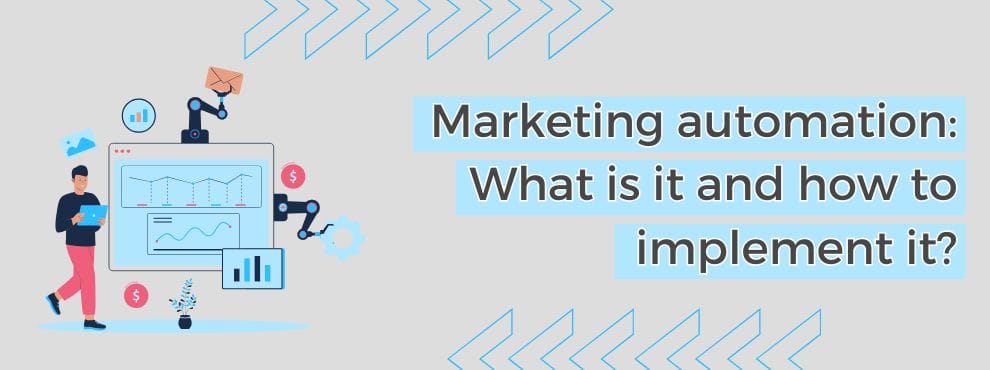In an increasingly digitized world, companies are looking for ways to optimize their processes and become more efficient in managing their customer relationships. Marketing automation has emerged as a powerful solution to simplify repetitive tasks and improve the effectiveness of campaigns, allowing teams to focus on more strategic tasks. Butwhat does marketing automation really mean and how can it be implemented effectively? In this article, from IDX Innovadeluxe, we will explore this key concept and offer a guide to get the most out of it.
Table of contents
what is marketing automation?
Marketing automation refers to the use of software and technologies to manage marketing processes automatically, with the aim of improving efficiency and increasing the relevance of campaigns. It involves the creation of customized workflows that allow companies to communicate with their customers at the right time and with the right message, without constant manual intervention.
This type of automation covers a wide range of activities, from sending automated emails based on user behavior to scheduled posting on social networks. It’s about eliminating repetitive tasks, such as database segmentation and post scheduling, so that marketing teams can spend more time on strategy and creativity.
Benefits of marketing automation
Marketing automation not only saves time, but also has a significant impact on overall campaign performance. Here are some of the most prominent benefits:
1. Personalization at scale
Thanks to automation, brands can segment their audiences and send highly personalized messages. This increases open and conversion rates because messages are more relevant to recipients.
2. Increased productivity
Marketing teams can focus on more important tasks, such as strategy planning and content creation, rather than being bogged down in routine activities. Automation removes the burden of repetitive tasks, allowing them to work more efficiently.
3. Continuous analysis and optimization
Marketing automation provides detailed information on campaign performance, enabling accurate analysis. Companies can identify what is working and what is not, making adjustments to continuously improve their results.
how to implement marketing automation?
Implementing marketing automation is not simply choosing software and turning it on; it requires planning, knowledge of business needs and careful execution. Here is a step-by-step approach to implementing it:
1. Define objectives and goals
The first step is to be clear about what you want to achieve with marketing automation – do you want to increase sales, improve customer retention or simply optimize your internal processes? Identifying your goals will help guide the design of your automated workflows and ensure that resources are allocated efficiently.
It is important to remember that goals should be specific and measurable. For example, if your goal is to increase conversion rates by 10%, you need to establish KPIs (key performance indicators) that allow you to monitor this progress.
2. Know your audience
Before you start automating, it is essential to understand your target audience. Marketing automation is most effective when it is based on accurate data about customer behavior and preferences. Conduct a thorough analysis of your customers, study their previous interactions with your brand, and segment your database into specific groups.
Knowing your audience will also help you create personalized messages that really connect with them. This includes tailoring content based on where they are in the customer journey, from lead generation to customer loyalty.
Selecting automation software
Once you have a clear idea of your goals and audience, it’s time to choose the right tool. There are many marketing automation platforms on the market, each with its own features and functionality. Some of the most popular include HubSpot, Mailchimp, ActiveCampaign, and Salesforce Marketing Cloud.
The selection should be based on your company’s specific needs. Some tools are best for email automation, while others excel at social media management or multichannel campaign automation. It’s important that the software chosen is easy to integrate with your current systems, such as your CRM (customer relationship management system) and e-commerce platform.
Creating automated workflows
Once you have the software, you can start designing workflows. Automated workflows are sequences of actions that are executed based on certain triggers. For example, if a customer registers on your website, a workflow could automatically send them a welcome email followed by a series of personalized emails that guide them through the sales funnel.
When designing these flows, it is important that they are flexible enough to adapt to the changing needs of your audience. You should also perform A/B testing to optimize every element, from email subjects to message content.
Integration with other channels
Marketing automation should not be limited to a single channel. It’s critical to integrate it with all customer touch points, such as social media, paid ads and push notifications. This ensures a consistent and seamless brand experience, no matter how a customer interacts with your company.
For example, you can set up retargeting campaigns that are automatically triggered when a user abandons their shopping cart in your online store. This way, a reminder is sent via email and relevant ads are displayed on social networks, increasing the chances of conversion.
Measuring and optimizing results
Automation is not a set-and-forget process. It is crucial to regularly measure the performance of your campaigns and adjust your strategies as needed. The detailed reports that automation tools generate can provide clear insight into which tactics are performing best.
If you see that certain emails are not being opened or click-through rates are low, it could be a sign that you need to change your content focus or review your sending times. Ongoing optimization is the key to maximizing ROI.
Conclusion
Marketing automation is an indispensable resource for businesses that want to stay competitive and efficient in a dynamic digital environment. From mass personalization to optimizing repetitive tasks, this technology has the potential to transform the way brands interact with their customers.
However, successful implementation requires a clear understanding of objectives, a well-thought-out strategy and a willingness to adapt based on the data obtained. At IDX Innovadeluxe, we are committed to helping you integrate these solutions so that your business not only automates processes, but also becomes an effective, success-oriented marketing machine.
it’s time to take the next step in your marketing strategy and harness the power of automation!
Related Posts







Deja un comentario